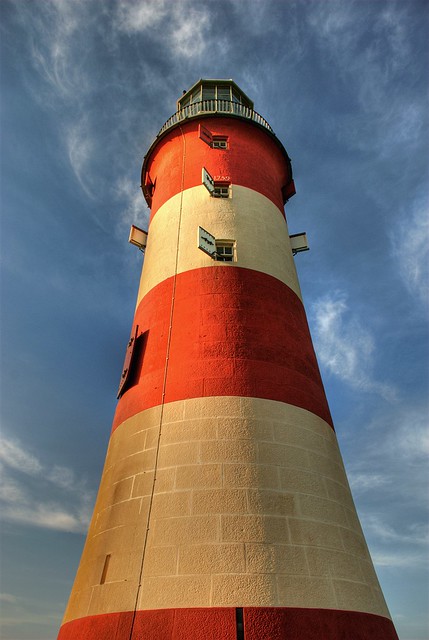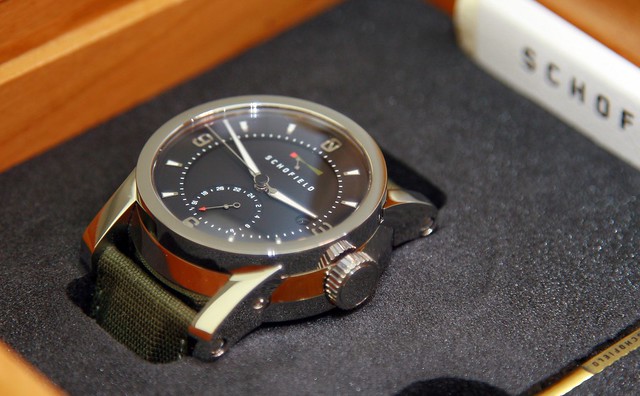 |
| The Eddystone Lighthouse, (C) Howzey |
A quick warning: I'm pretty sure that you will read / hear quite a bit about Schofield in the coming weeks. The East Sussex-based company seemed to capture the hearts and minds of many visitors to SalonQP 2011, who appeared to relish in another modern, vibrant English brand. I'll therefore probably spend more time talking about the elements of the watch, the nascent brand and its creators, rather than the technical specs, which can be found here on the Schofield 'site.
Schofield Watch is a new, small watchmaking company producing limited numbers of watches in Germany using Swiss Soprod movements. The watch has taken approximately 3,000 hours to build from first designs to the finished product, and is the first in a number of planned watches. There were two models shown at SalonQP: the Signalman GMT PR - a highly polished three hander with subsidiary GMT dial (300 pieces); and a second DLC version (100 pieces). The design of the watch takes elements from lighthouses, such as Smeaton's Tower - now on Plymouth Hoe (see photo opposite), Fresnel lens design (large aperture and short focal length) and the "beam of light" logo on the dial that doubles as a power reserve indicator. While I'm talking about Smeaton - a quick aside: did you know that John Smeaton provided a coefficient for the lift equation used by the Wright Brothers?**
In profile, the Signalman GMT PR *does* recall a lighthouse: the heavily chamfered case starts at 44mm at the base and rises to 42mm at the top, in a heavily stepped manner. In profile, there's a certain lighthouse-esque feel to it too - the 2.5mm sapphire crystal is seated underneath the lip of the highly polished bezel, forming a slight 'Fresnel' effect (Fresnel lenses are split into a series of annular Fresnel zones). To look too deeply into the Signalman / lighthouse motif might risk missing the point of the watch: a fairly simple, almost austere dial in a large, uncluttered case, with strong anti-magnetic properties and a solid 500m water resistance. The straps are also worth a mention - 24mm tapering to 22mm: the green canvas has a particular strong look to it and seems to go well with the "military" look of the watch. The oversized 10mm crown continues this theme.
Speaking to Giles Ellis, the designer behind the watch, the design of the watch box (maple), and the brass GMT adjustment tool, are just as important as the finished piece. Indeed, a great deal of thought appears to have gone into almost every detail of this package: the GMT dial is, for example, rather unusually adjusted through a small screw in the lower right lug. I'm not sure exactly what this (rather old school system) adds to the ease of use but it does demonstrate a desire to challenge certain norms. Matt, who was brought on board to help with the marketing, told me that the original tool was hand-fashioned by Giles from a single piece of metal. It's certainly the nicest, most satisfying GMT-pusher-type tool I've ever seen, but it does seem a little extraneous. Another slight negative is the date window - it's a small, rather deep hole at three o'clock, that I found quite difficult to read at a glance. But that's probably just me.
The highly polished case is also rather intriguing. Schofield has built a case that incorporates a highly anti-magnetic cage around the movement (similar, it seems, to the soft iron core sandwich used in many Bremont watches). The apparently matte black dial is, in fact, the top portion of this cage, cast in brass and painted with a copper oxide coating. All this is finished in a case of such high polish that I found it almost impossible to photograph (see token effort above). The mirrored polish is echoed in the use of applied markers on the dial, including a "zero" marker at twelve. Intervening markers are large and filled with C1 Luminova - a particularly bright, startling white lume. The whole design is nothing if not coherent: all elements point to a very simple, easy to read and very forceful watch. It has significant presence on the wrist and will certainly garner its fair share of comments (as evidenced by the almost constant stream of visitors that seemed to be drawn to their stand at SalonQP).
All in all, as you may have gathered, I rather like the Schofield Signalman. However, it *is* expensive - even at the pre-order prices (and including the rather natty milled aluminium cigar holder and Romeo y Julieta that's included as a freebie). But it's always good to see another British watch manufacturer on the scene, especially one with such a strong design - even if the pieces themselves are produced (understandably) in Germany.
I would really like to get my hands on one to test - if only to try and take some better photos!
**EDIT: apparently, the Smeaton pressure co-efficient was a little off, and has since been amended, largely because of the later use of dynamic pressure.
 |
| Maple presentation box and GMT pusher tool |
 |
| The Lighthouse motif on the back of the Signalman |
 |
| The Schofield Signalman GMT PR |
All in all, as you may have gathered, I rather like the Schofield Signalman. However, it *is* expensive - even at the pre-order prices (and including the rather natty milled aluminium cigar holder and Romeo y Julieta that's included as a freebie). But it's always good to see another British watch manufacturer on the scene, especially one with such a strong design - even if the pieces themselves are produced (understandably) in Germany.
I would really like to get my hands on one to test - if only to try and take some better photos!
**EDIT: apparently, the Smeaton pressure co-efficient was a little off, and has since been amended, largely because of the later use of dynamic pressure.
No comments:
Post a Comment